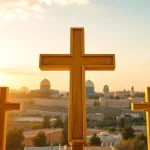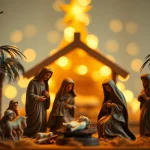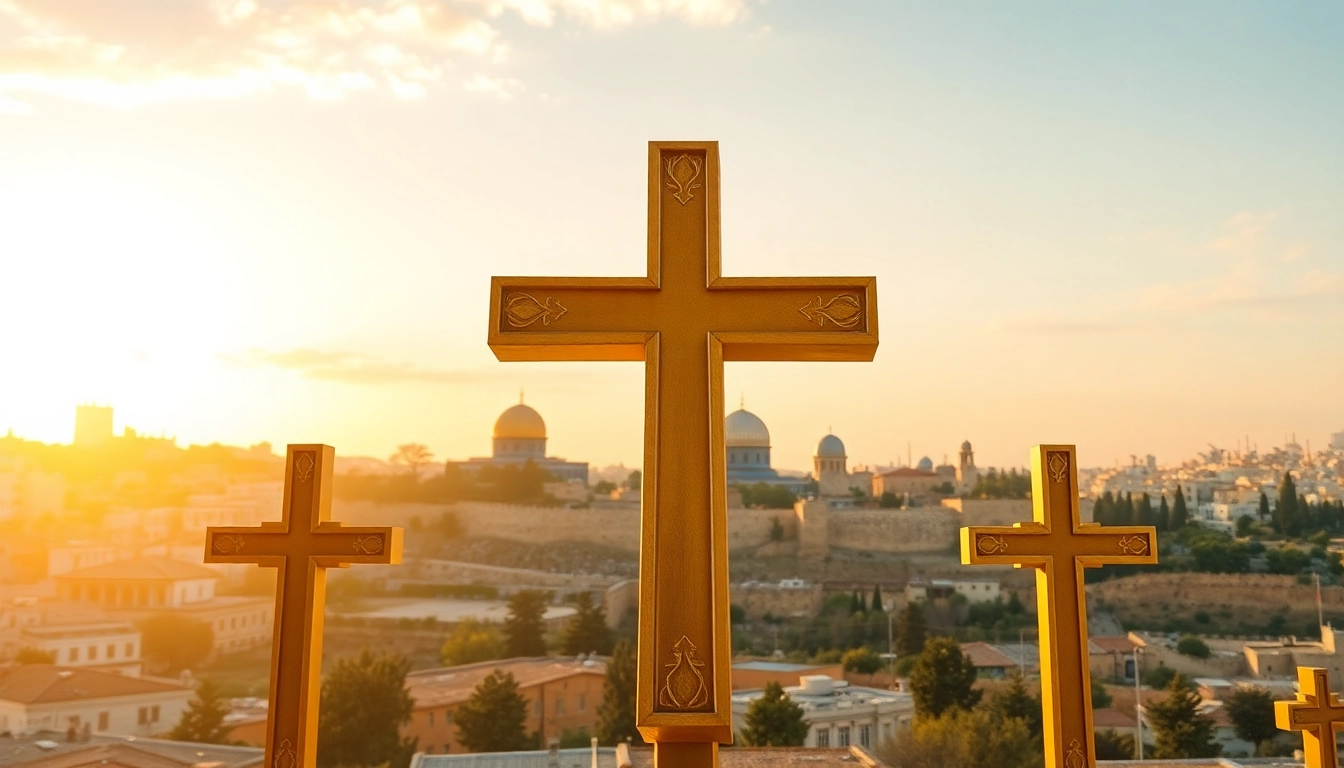The Historical Context of Jerusalem crosses
The Origin and Evolution
The Jerusalem crosses trace their roots back to the early Christian era, becoming a significant symbol during the Crusades in the 11th century. This heraldic design features a large central cross, often referred to as a cross potent, surrounded by four smaller Greek crosses, positioned in each quadrant. This intricate arrangement has deep symbolic meanings, often interpreted as representing the Four Evangelists and the spread of Christianity throughout the world.
The evolution of the Jerusalem cross can be understood through its representation in various historical contexts. Initially, it symbolized the Kingdom of Jerusalem, which was established after the First Crusade. Over time, as the Crusaders and pilgrims returned home with tales of their adventures, the symbol became a marker of faith and territorial claims, expanding its influence throughout Europe and among Christian communities.
The Role in Christian Symbolism
In Christian iconography, the Jerusalem cross serves as a powerful emblem of faith and commitment to the teachings of Jesus Christ. Each of the four smaller crosses is often interpreted as a representation of the four corners of the world to which the Gospel was preached, reinforcing the mission of evangelism central to Christianity. The large cross is frequently seen as a reminder of Christ’s sacrifice.
This cross is also used in various Christian denominations, including Roman Catholic, Anglican, and Protestant traditions, reflecting its universal appeal as a symbol of hope and redemption. The Jerusalem cross encapsulates the message of spreading love, faith, and community, which resonates with individuals regardless of their specific doctrinal beliefs.
Jerusalem crosses in Medieval History
Throughout the medieval period, the Jerusalem cross became intertwined with the identity of the Crusader states. It was used on flags, coats of arms, and various artifacts, solidifying its place in the history of the Crusades. This period saw the cross become not just a symbol of faith but also one of conquest and territorial ambition, marking the landscape of early Medieval Europe.
The significance of the Jerusalem cross heightened as it evolved into a national emblem. For many, it represented the ideals of chivalry, religious devotion, and the crusading spirit. Additionally, the cross was associated with various orders of knighthood and military orders, such as the Knights Templar and the Order of the Holy Sepulchre, which further entrenched its place in medieval symbolism.
The Design and Meaning of Jerusalem crosses
Architectural Significance
The architectural utilization of the Jerusalem cross has been prominent, particularly in churches and cathedrals throughout Europe. The cross’s distinct design has allowed it to be incorporated into various buildings, offering a visual representation of faith integrated into the very fabric of communities.
From grand cathedrals to humble chapels, the Jerusalem cross can be found adorning altars and facades, serving as a focal point for worship and reflection. As a design element, it invites contemplation and offers a tangible connection to the divine. The intersection of form and function in such architectural instances illustrates the cross’s dual role as a symbol and a tool for spiritual engagement.
Artistic Interpretations Throughout Time
Artistic expressions of the Jerusalem cross have varied across cultures and time periods. From illuminated manuscripts to modern jewelry designs, artists have utilized the cross to convey messages of faith, hope, and resilience. Paintings and sculptures often depict the cross intertwined with other symbols of Christianity, showcasing its importance within the broader artistic narrative of faith.
In contemporary art, the Jerusalem cross continues to inspire numerous interpretations, reflecting personal beliefs and the ever-evolving dialogue around spirituality. Artists often challenge traditional motifs and imbue personal narratives into their works, utilizing the cross as a means to explore complex themes of identity, faith, and community.
Modern Usage and Variations
Today, the Jerusalem cross can be found in various forms, from jewelry pieces to wall decor, reflecting its enduring appeal. Contemporary artisans often draw upon traditional craftsmanship methods, blending ancient techniques with modern aesthetics to create pieces that resonate with today’s audiences. This movement not only preserves cultural heritage but also allows individuals to connect with their faith in personal, meaningful ways.
There are various adaptations of the Jerusalem cross, including stylized versions that may emphasize certain elements over others, catering to diverse tastes and preferences. These modern interpretations serve as both decorative and devotional items, allowing individuals to express their spiritual beliefs while also serving as aesthetic focal points.
Spirituality and the Jerusalem crosses
Symbolism within Christian Faith
The Jerusalem cross embodies profound spiritual significance within Christianity. Its design serves as a tangible reminder of Christ’s life and sacrifice, emphasizing themes of redemption, forgiveness, and eternal life. For many believers, wearing or displaying the Jerusalem cross serves as an affirmation of their faith and a commitment to the teachings of Jesus.
In prayer and meditation, individuals often use the Jerusalem cross to foster deeper connections with their spirituality. It acts as a bridge, linking the physical world with the divine, creating a sacred space for reflection and spiritual growth.
Personal Reflections and Beliefs
For countless individuals, the Jerusalem cross is more than just a symbol; it represents personal stories of faith, hope, and perseverance. Many choose to wear the cross as a source of inspiration, reminding them of their beliefs during hardships or moments of doubt. It has become common to share personal narratives involving the cross, further deepening its significance within communities.
Such reflections highlight the communal aspect of spirituality—how personal experiences can resonate with others and create bonds. This shared understanding of the Jerusalem cross fosters a sense of connection among believers and invites ongoing dialogue about faith and personal experiences.
Ritualistic Importance of Jerusalem crosses
The Jerusalem cross often plays a crucial role in various religious rituals and ceremonies across Christian denominations. Whether in baptisms, weddings, or memorial services, the cross serves as a sacred emblem, infusing rituals with a deeper significance. It represents the beliefs that underpin these significant life events and acts as a means of acknowledging a higher power in these key milestones.
During communal worship, the presence of the Jerusalem cross can reinforce the unity of believers, inviting them to gather under a shared emblem of faith. This collective experience not only strengthens individual spirituality but also fosters a sense of belonging within the broader community.
Crafting Jerusalem crosses: Techniques and Materials
Traditional Craftsmanship Techniques
The craftsmanship surrounding the creation of Jerusalem crosses is a blend of tradition, skill, and artistry. Artisan makers often employ techniques passed down through generations, utilizing ancient carving methods, metalworking, and other handcraft practices. This dedication to traditional craftsmanship enhances the cross’s spiritual and cultural value, offering a physical connection to history.
Artisans often take pride in using locally sourced materials, which not only supports local economies but also ties the creations to the land of their origin. The use of traditional methods embodies respect for the craft and the historical context within which these crosses were initially made.
Materials Used in Making Jerusalem crosses
A variety of materials are commonly used to create Jerusalem crosses, each contributing to the overall look and feel of the final piece. Wood, particularly olive wood from the Holy Land, has significant spiritual value and is favored by many artisans. Metal, including silver and gold-plated finishes, can also be found, appealing to those who prefer a more luxurious aesthetic.
Additionally, contemporary makers often experiment with materials like ceramics and glass, pushing the boundaries of traditional designs while still honoring the cross’s symbolic importance. Each material selected carries its essence, enhancing the cross’s unique story and appeal.
Contemporary Approaches and Innovations
Innovations in design and production processes have allowed for broader interpretations of the Jerusalem cross. Contemporary artisans are increasingly incorporating new technologies, such as laser cutting and 3D printing, to create more intricate patterns and designs. These methods allow for greater customization, accommodating individual preferences while maintaining the emblem’s core significance.
This merging of traditional and modern techniques ensures that the Jerusalem cross continues to remain relevant, allowing new generations to forge a connection with their faith in unique and dynamic ways. By embracing both innovation and tradition, artisans contribute to a thriving industry that keeps the Jerusalem cross alive and cherished.
Collecting and Appreciating Jerusalem crosses
How to Start a Collection
Starting a collection of Jerusalem crosses can be a fulfilling endeavor, providing opportunities for personal reflection and cultural exploration. An interested collector should begin by researching various styles and designs, which encompass different historical periods and cultural interpretations. By understanding the context and variations, collectors can make informed choices about their acquisitions.
Connecting with local artisans, visiting art galleries, or participating in craft fairs are great ways to discover unique pieces. Engaging with communities online can also provide insights into obtaining authentic items. A collector’s journey is not solely about the acquisition itself but also encompasses the narratives and stories behind each piece.
Valuation and Authenticity Concerns
As with any collectible item, understanding valuation is vital for collectors of Jerusalem crosses. The worth of a cross often depends on factors such as craftsmanship, rarity, historical significance, and condition. Engaging with experts in art appraisals can provide clarity on the right price points and help ensure authenticity in potential purchases.
Moreover, collectors should be cautious of reproductions, especially as the popularity of Jerusalem crosses has led to the rise of mass-produced versions. Building a relationship with reputable dealers and seeking documentation for pieces can safeguard against counterfeit items.
Displaying Jerusalem crosses in Art and Home
Displaying Jerusalem crosses can enhance home decor while providing a continual reminder of faith and community. Thoughtful placements in homes, such as in prayer corners, living rooms, or entryways, allow the cross to serve not only as a decorative piece but also as a focal point for spiritual reflection.
Curating a display of Jerusalem crosses can be a personal artistic expression. Grouping different styles and sizes can create a powerful visual narrative that speaks to an individual’s faith journey. Incorporating lighting techniques can enhance the display’s overall ambiance, inviting contemplative engagement with each piece.









